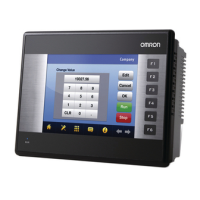OMRON CHAPTER 14 – Using CX-Supervisor as an OPC Client
Release 2.0 Page 233
Freedom of choice
With the introduction of OPC-compliant manufacturing automation products, users are provided their
due right to select and implement systems comprised of best-in-class components without the pain of
custom interfaces. This user benefit is sometimes referred to as “freedom of choice.” For example,
both Netscape and Internet Explorer can browse the web equally well, but people use the browser
they like best. As a result of this freedom of choice, vendors will need to become more competitive
and offer superior products and solutions to maintain their customers. Besides freedom of choice, the
user also has vendor independence, or “freedom from a proprietary lock.” If the implemented control
system is comprised of modules with proprietary interfaces, any customer who desires to upgrade any
component function of the integrated whole is entirely dependent on the vendor. With OPC
components, only the module of interest must be upgraded and not the entire system. The
requirement to use the original vendor is eliminated. High-priced proprietary solutions (and their
expensive after-sale support contracts) will yield to lower cost OPC-enabled alternatives.
Time Reduction through Lower System Integration Costs
OPC eliminates the need for costly custom software integration. OPC provides plug-and-play
software and hardware components from a variety of automation software, device, and system
suppliers. Process and manufacturing companies can easily integrate applications into corporate-wide
automation and business systems, something that has been virtually unachievable in the past. OPC-
compatible components greatly reduce system integration costs because all software and hardware
components adhere to a single, standard interface that’s being adopted around the world. Automation
suppliers are providing hardware devices with integrated OPC servers that are replacing proprietary
device-driver software. The driver connection between hardware and software from different vendors
has historically been the number one headache in system integration. OPC offers the opportunity to
ease the pain and shorten the application development cycle. This gets automation projects up faster,
which saves time for new projects and brings the benefit of automation to the process sooner.
Who should care about OPC?
You should care about OPC if your applications are largely run in personal computers and you are
involved with solving plant integration problems. As a critical mass of servers and OPC-enabled
applications become available, OPC is likely to become an important part of your plant integration
tool set. The OPC specification promises a future without proprietary interfaces that will greatly
benefit both manufacturing customers and automation suppliers.

